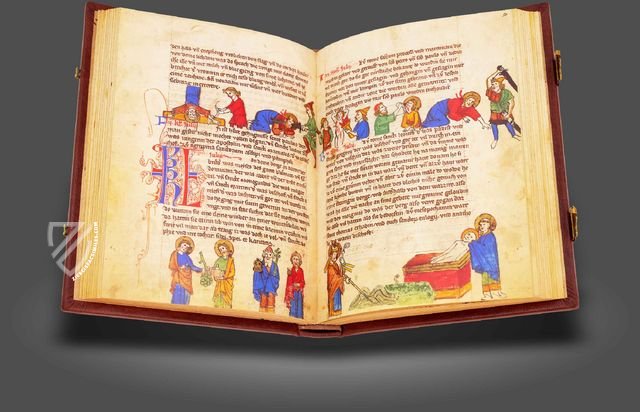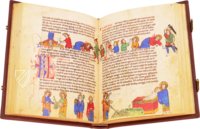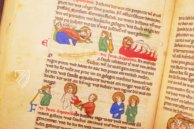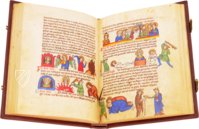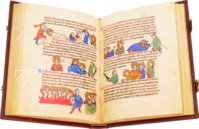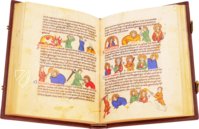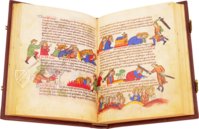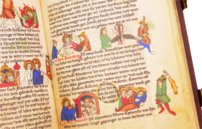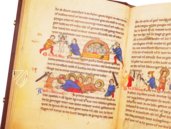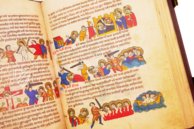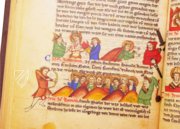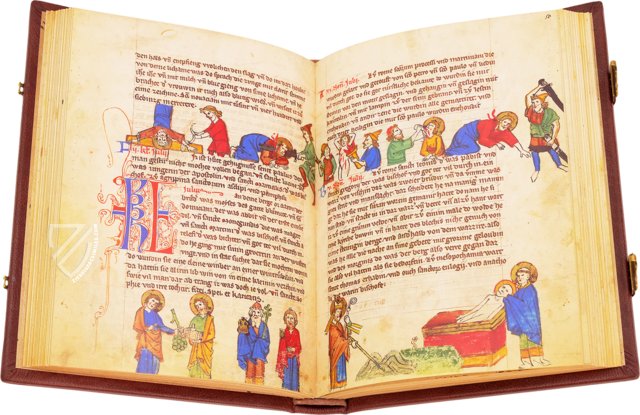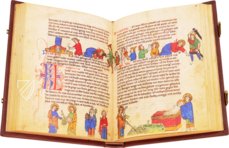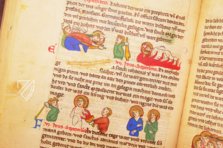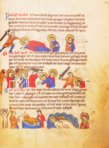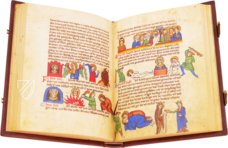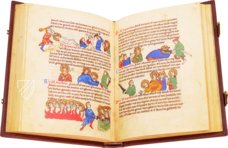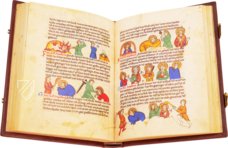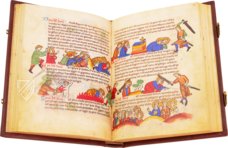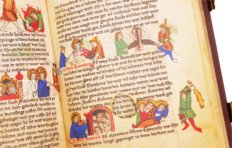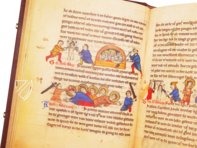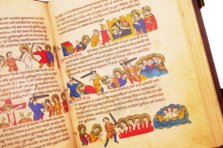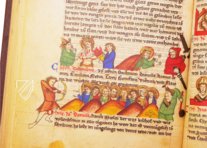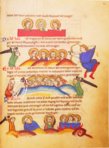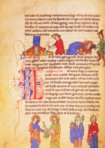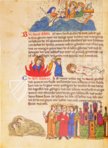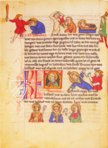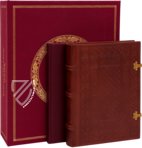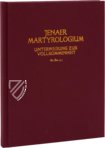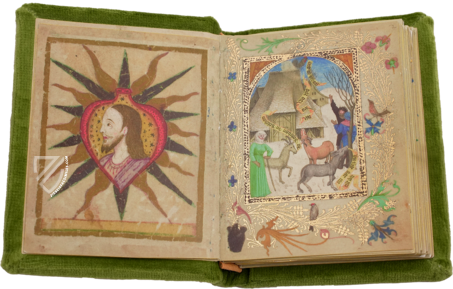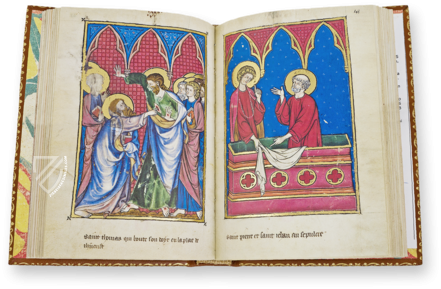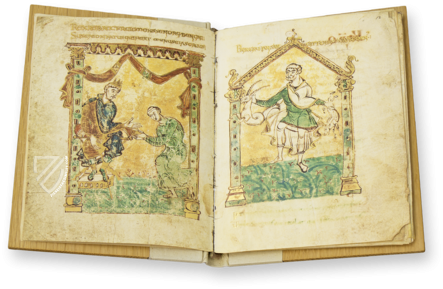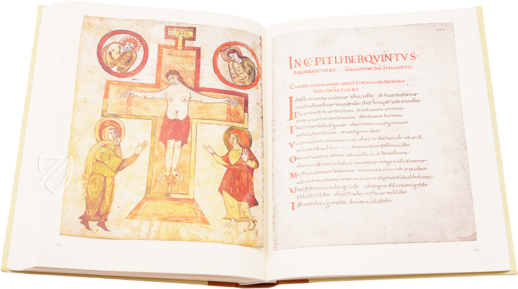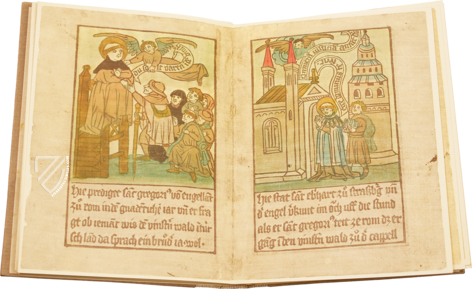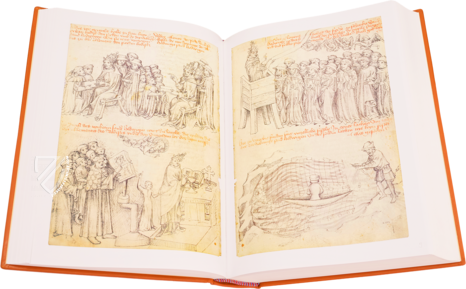Jena Martyrology
(3,000€ - 7,000€)
Named after its modern repository, the Jena Martyrology is the oldest work of its kind written in the German language. Created ca. 1275, it is based on other martyrologies by Ado of Vienne, Notker and Usuard. This gem of book art was bound by Nikolaus von Havelberg and is a fine example of the bookbinding work that was done in Erfurt at the time. 366 delicate pen drawings with rich primary colors and illuminated with gold and silver are inserted directly into the text and are five lines tall on average. These images interwoven into the text have an evocative and animating narrative effect on the reader. The magnificent manuscript preserves two extremely rare vernacular prose translations, as well as the spiritual doctrinal poem Unterweisung zur Vollkommenheit or “Instruction for Perfection” in Middle German – the Jena Codex is the oldest, only completely, and also excellently illustrated specimen to survive.
Jena Martyrology
A martyrology or calendarium sanctorum, is a catalog of saints, mostly martyrs, who are usually attributed to the day of their death, which is also their day of remembrance. The Memoria of their martyrdoms had a fixed place in the liturgy, but also in the tightly organized daily schedule of the monks and nuns. Therefore, the respective passages from a martyrology such as the one in the Thuringian University and State Library were read out.
The Martyrdoms of the Saints in Thuringian
The Jena Martyrology was probably written around 1275 for an unknown patron and is thus the oldest surviving German-language martyrology. The dialect of the writing language indicates that the text was written in Thuringia, although it was not a completely new work, but rather a copy of a manuscript from the middle of the 13th century. The codex was probably used in a liturgical context: research assumes that the martyrdoms were recited by a reader to a clerical audience with insufficient knowledge of Latin after the common choral prayer.
Gilded Images of Death and Torture
The text of the Jena Martyrology is based on earlier martyrologies by various Carolingian authors, including Ados of Vienne (799–875), Notker (around 840–912) and Usuard († 877). The entries range from simple enumerations to more detailed accounts of individual saints' legends. The martyrdoms are not only recorded textually, but are also brought to the reader's attention visually.
Almost every daily entry is accompanied by a five-line picture strip in bright colors. Only the entry for December 17 (f. 103r-v) was illuminated twice, while the one for June 30 (f. 49v) was not illuminated at all - probably for reasons of space. The total of 366 colored pen and ink drawings decorated with gold and silver mainly show the saints, but some also depict architecture, ships and other objects, some of which have or had specific real-life counterparts.
Instruction to Perfection
It is not only the extensive and splendid illumination that makes the Jena Martyrology a true treasure of medieval book illumination. The last pages of the manuscript also contain the spiritual didactic poem Unterweisung zur Vollkommenheit, which has been handed down to us uniquely and solely in the Jena codex.
In the couplet rhymes, an anonymous narrator, who introduces himself as a poor man and is thus all the more suitable as a spiritual advisor, first laments his own imperfection while invoking Mary and Christ. Mary then gives him advice, whereupon the author instructs the reader on how to achieve perfection in the Christian-ascetic sense.
The moralizing text also differs from the martyrology in several respects: the poem was written in two columns and not illuminated – but was nevertheless created by the same hand.
A Gem of the Elector's Library
The codex did not receive its brown calfskin binding with lily-shaped brass clasps, which is also reproduced in the facsimile edition, until around 1500, when it was housed in the Bibliotheca Electoralis, the palace and university library at Wittenberg founded by the Saxon Elector Frederick the Wise (1463–1525). The decorative binding is the work of the Erfurt bookbinder Nikolaus von Havelberg (fl. 1477–1505). It is not known how the manuscript came to Wittenberg. However, the martyrology came to Jena as early as 1549 together with the rest of the Bibliotheca Electoralis when Elector Johann Friedrich (1503–1554) lost the electoral district of Wittenberg.
Codicology
- Alternative Titles
- Jenaer Martyrologium
- Size / Format
- 226 pages / 24.3 × 18.5 cm
- Origin
- Germany
- Date
- Ca. 1275
- Epochs
- Style
- Language
- Script
- Gothic textura
- Illustrations
- 366 mostly five-line colored pen and ink drawings
- Content
- Martyrologium (ff. 1r-109v); poem "Unterweisung zur Vollkommenheit" (ff. 110r-112v)
- Previous Owners
- Bibliotheca Electoralis of Frederick III in Wittenberg (Thuringia)
Jena Martyrology
The Fifth Day before the Nones of October
This picture strip not only visualizes the story of two saints who are commemorated "ante diem quintum Nonas Octobris", i.e. on October 3, but also features a colourful illumination of the city of Cologne, including Cologne Cathedral. The text tells of Bishop Willibrord (ca. 658–739), who, together with two priests, wanted to missionize the "Saxon country". However, they were killed by "the pagans" while preaching and thrown into "a great water" - the Rhine? By a miracle, their bodies, shown on the left, swam against the current to Cologne, where they were "buried with great honor". In the image, the washed-up bodies have just been discovered by a group of clergymen, who are clearly quite astonished by this.
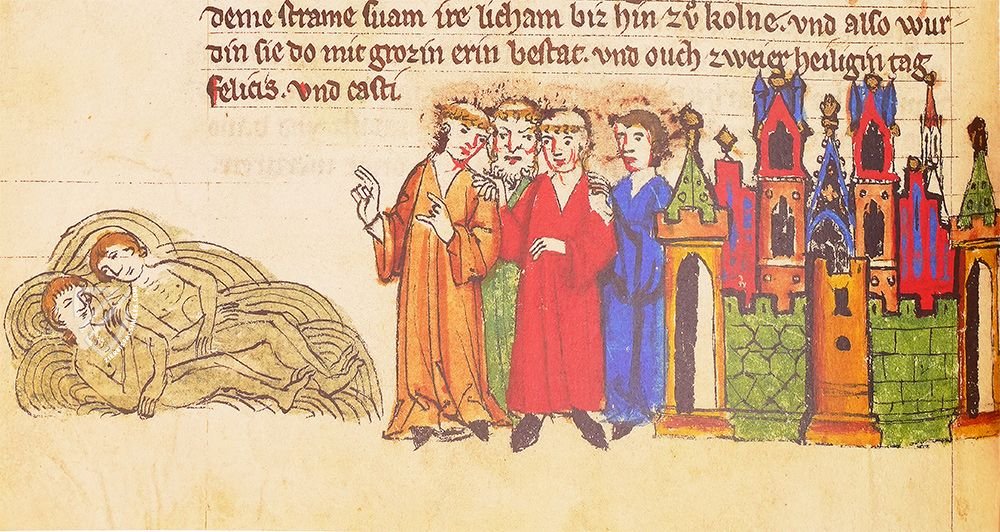
Jena Martyrology
Calends of July
In the late antique Julian calendar, which was the basis for all dating in the Middle Ages, the first day of the month was called 'Kalendae'. This day is usually visually accentuated in calendars, but also in martyrologies such as this one, by a decorative initial ligature of the letters K and L. The lower section of this page lists the saints whose deaths were commemorated on the calends of the month of Julius, i.e. July 1st. These include St. Arelefus and one of his companions, the high priest Aaron and possibly Martin of Vienne, who are shown in this order at the bottom of the page. Saint Monegundis and Saint Sophie of Milan and her daughters Fides, Spes and Karitas are also mentioned.
The section above is about the saints who are commemorated two days before the 'Kalendis Juli', i.e. on June 29. As victims of the persecution of Christians under Emperor Nero usually depicted together, the apostles Peter and Paul were particularly venerated on this day in the Middle Ages. They both appear in their respective martyrdoms – Paul on the left, Peter on the right.
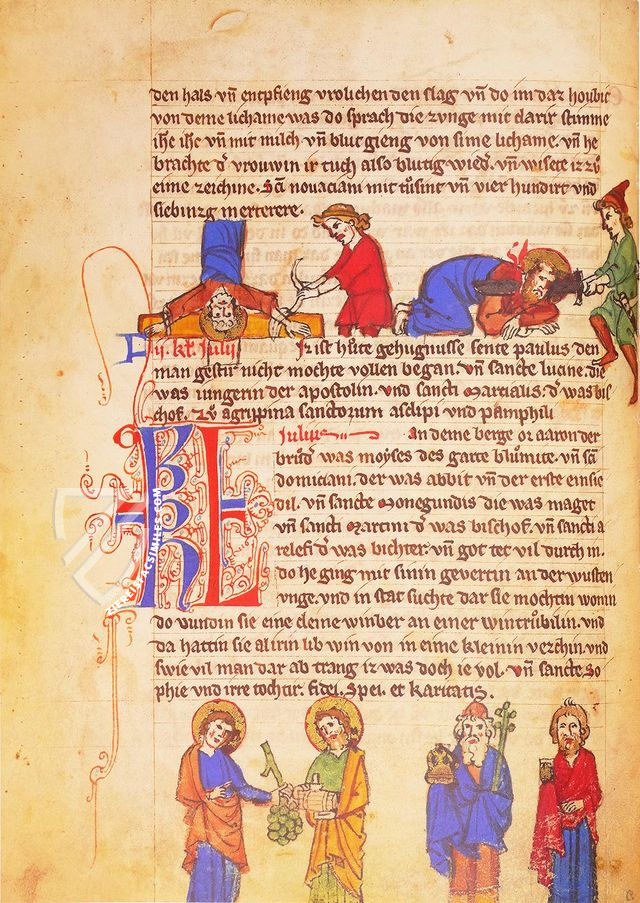
#1 Jenaer Martyrologium
Language: German
(3,000€ - 7,000€)
- Treatises / Secular Books
- Apocalypses / Beatus
- Astronomy / Astrology
- Bestiaries
- Bibles / Gospels
- Chronicles / History / Law
- Geography / Maps
- Saints' Lives
- Islam / Oriental
- Judaism / Hebrew
- Single Leaf Collections
- Leonardo da Vinci
- Literature / Poetry
- Liturgical Manuscripts
- Medicine / Botany / Alchemy
- Music
- Mythology / Prophecies
- Psalters
- Other Religious Books
- Games / Hunting
- Private Devotion Books
- Other Genres
- Afghanistan
- Armenia
- Austria
- Belgium
- Belize
- Bosnia and Herzegovina
- China
- Colombia
- Costa Rica
- Croatia
- Cyprus
- Czech Republic
- Denmark
- Egypt
- El Salvador
- Ethiopia
- France
- Germany
- Greece
- Guatemala
- Honduras
- Hungary
- India
- Iran
- Iraq
- Israel
- Italy
- Japan
- Jordan
- Kazakhstan
- Kyrgyzstan
- Lebanon
- Liechtenstein
- Luxembourg
- Mexico
- Morocco
- Netherlands
- Palestine
- Panama
- Peru
- Poland
- Portugal
- Romania
- Russia
- Serbia
- Spain
- Sri Lanka
- Sweden
- Switzerland
- Syria
- Tajikistan
- Turkey
- Turkmenistan
- Ukraine
- United Kingdom
- United States
- Uzbekistan
- Vatican City
- A. Oosthoek, van Holkema & Warendorf
- Aboca Museum
- Ajuntament de Valencia
- Akademie Verlag
- Akademische Druck- u. Verlagsanstalt (ADEVA)
- Aldo Ausilio Editore - Bottega d’Erasmo
- Alecto Historical Editions
- Alkuin Verlag
- Almqvist & Wiksell
- Amilcare Pizzi
- Andreas & Andreas Verlagsbuchhandlung
- Archa 90
- Archiv Verlag
- Archivi Edizioni
- Arnold Verlag
- ARS
- Ars Magna
- ArtCodex
- AyN Ediciones
- Azimuth Editions
- Badenia Verlag
- Bärenreiter-Verlag
- Belser Verlag
- Belser Verlag / WK Wertkontor
- Benziger Verlag
- Bernardinum Wydawnictwo
- BiblioGemma
- Biblioteca Apostolica Vaticana (Vaticanstadt, Vaticanstadt)
- Bibliotheca Palatina Faksimile Verlag
- Bibliotheca Rara
- Boydell & Brewer
- Bramante Edizioni
- Bredius Genootschap
- Brepols Publishers
- British Library
- C. Weckesser
- Caixa Catalunya
- Canesi
- CAPSA, Ars Scriptoria
- Caratzas Brothers, Publishers
- Carus Verlag
- Casamassima Libri
- Centrum Cartographie Verlag GmbH
- Chavane Verlag
- Christian Brandstätter Verlag
- Circulo Cientifico
- Club Bibliófilo Versol
- Club du Livre
- CM Editores
- Collegium Graphicum
- Collezione Apocrifa Da Vinci
- Comissão Nacional para as Comemorações dos Descobrimentos Portugueses
- Coron Verlag
- Corvina
- CTHS
- D. S. Brewer
- Damon
- De Agostini/UTET
- De Nederlandsche Boekhandel
- De Schutter
- Deuschle & Stemmle
- Deutscher Verlag für Kunstwissenschaft
- DIAMM
- Droz
- E. Schreiber Graphische Kunstanstalten
- Ediciones Boreal
- Ediciones Grial
- Ediclube
- Edições Inapa
- Edilan
- Editalia
- Edition Deuschle
- Edition Georg Popp
- Edition Leipzig
- Edition Libri Illustri
- Editiones Reales Sitios S. L.
- Éditions de l'Oiseau Lyre
- Editions Medicina Rara
- Editorial Casariego
- Editorial Mintzoa
- Editrice Antenore
- Editrice Velar
- Edizioni Edison
- Egeria, S.L.
- Eikon Editores
- Electa
- Emery Walker Limited
- Enciclopèdia Catalana
- Eos-Verlag
- Ephesus Publishing
- Ernst Battenberg
- Eugrammia Press
- Extraordinary Editions
- Fackelverlag
- Facsimila Art & Edition
- Facsimile Editions Ltd.
- Facsimilia Art & Edition Ebert KG
- Faksimile Verlag
- Feuermann Verlag
- Folger Shakespeare Library
- Franco Cosimo Panini Editore
- Friedrich Wittig Verlag
- Fundación Hullera Vasco-Leonesa
- G. Braziller
- Gabriele Mazzotta Editore
- Gebr. Mann Verlag
- Gesellschaft für graphische Industrie
- Getty Research Institute
- Giovanni Domenico de Rossi
- Giunti Editore
- Graffiti
- Grafica European Center of Fine Arts
- Guido Pressler
- Guillermo Blazquez
- Gustav Kiepenheuer
- H. N. Abrams
- Harrassowitz
- Harvard University Press
- Helikon
- Hendrickson Publishers
- Henning Oppermann
- Herder Verlag
- Hes & De Graaf Publishers
- Hoepli
- Holbein-Verlag
- Houghton Library
- Hugo Schmidt Verlag
- Idion Verlag
- Il Bulino, edizioni d'arte
- ILte
- Imago
- Insel Verlag
- Insel-Verlag Anton Kippenberger
- Instituto de Estudios Altoaragoneses
- Instituto Nacional de Antropología e Historia
- Introligatornia Budnik Jerzy
- Istituto dell'Enciclopedia Italiana - Treccani
- Istituto Ellenico di Studi Bizantini e Postbizantini
- Istituto Geografico De Agostini
- Istituto Poligrafico e Zecca dello Stato
- Italarte Art Establishments
- Jan Thorbecke Verlag
- Johnson Reprint Corporation
- Josef Stocker
- Josef Stocker-Schmid
- Jugoslavija
- Karl W. Hiersemann
- Kasper Straube
- Kaydeda Ediciones
- Kindler Verlag / Coron Verlag
- Kodansha International Ltd.
- Konrad Kölbl Verlag
- Kurt Wolff Verlag
- La Liberia dello Stato
- La Linea Editrice
- La Meta Editore
- Lambert Schneider
- Landeskreditbank Baden-Württemberg
- Leo S. Olschki
- Les Incunables
- Liber Artis
- Library of Congress
- Libreria Musicale Italiana
- Lichtdruck
- Lito Immagine Editore
- Lumen Artis
- Lund Humphries
- M. Moleiro Editor
- Maison des Sciences de l'homme et de la société de Poitiers
- Manuscriptum
- Martinus Nijhoff
- Maruzen-Yushodo Co. Ltd.
- MASA
- Massada Publishers
- McGraw-Hill
- Metropolitan Museum of Art
- Militos
- Millennium Liber
- Müller & Schindler
- Nahar - Stavit
- Nahar and Steimatzky
- National Library of Wales
- Neri Pozza
- Nova Charta
- Oceanum Verlag
- Odeon
- Orbis Mediaevalis
- Orbis Pictus
- Österreichische Staatsdruckerei
- Oxford University Press
- Pageant Books
- Parzellers Buchverlag
- Patrimonio Ediciones
- Pattloch Verlag
- PIAF
- Pieper Verlag
- Plon-Nourrit et cie
- Poligrafiche Bolis
- Presses Universitaires de Strasbourg
- Prestel Verlag
- Princeton University Press
- Prisma Verlag
- Priuli & Verlucca, editori
- Pro Sport Verlag
- Propyläen Verlag
- Pytheas Books
- Quaternio Verlag Luzern
- Reales Sitios
- Recht-Verlag
- Reichert Verlag
- Reichsdruckerei
- Reprint Verlag
- Riehn & Reusch
- Roberto Vattori Editore
- Rosenkilde and Bagger
- Roxburghe Club
- Salerno Editrice
- Saltellus Press
- Sandoz
- Sarajevo Svjetlost
- Schöck ArtPrint Kft.
- Schulsinger Brothers
- Scolar Press
- Scrinium
- Scripta Maneant
- Scriptorium
- Shazar
- Siloé, arte y bibliofilia
- SISMEL - Edizioni del Galluzzo
- Sociedad Mexicana de Antropología
- Société des Bibliophiles & Iconophiles de Belgique
- Soncin Publishing
- Sorli Ediciones
- Stainer and Bell
- Studer
- Styria Verlag
- Sumptibus Pragopress
- Szegedi Tudomànyegyetem
- Taberna Libraria
- Tarshish Books
- Taschen
- Tempus Libri
- Testimonio Compañía Editorial
- Thames and Hudson
- The Clear Vue Publishing Partnership Limited
- The Facsimile Codex
- The Folio Society
- The Marquess of Normanby
- The Richard III and Yorkist History Trust
- Tip.Le.Co
- TouchArt
- TREC Publishing House
- TRI Publishing Co.
- Trident Editore
- Tuliba Collection
- Typis Regiae Officinae Polygraphicae
- Union Verlag Berlin
- Universidad de Granada
- University of California Press
- University of Chicago Press
- Urs Graf
- Vallecchi
- Van Wijnen
- VCH, Acta Humaniora
- VDI Verlag
- VEB Deutscher Verlag für Musik
- Verlag Anton Pustet / Andreas Verlag
- Verlag Bibliophile Drucke Josef Stocker
- Verlag der Münchner Drucke
- Verlag für Regionalgeschichte
- Verlag Styria
- Vicent Garcia Editores
- W. Turnowski Ltd.
- W. Turnowsky
- Waanders Printers
- Wiener Mechitharisten-Congregation (Wien, Österreich)
- Wissenschaftliche Buchgesellschaft
- Wissenschaftliche Verlagsgesellschaft
- Wydawnictwo Dolnoslaskie
- Xuntanza Editorial
- Zakład Narodowy
- Zollikofer AG

